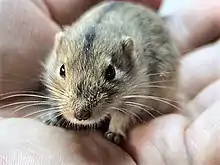| Lagurus Temporal range: Late Pliocene to Recent | |
|---|---|
 | |
| Steppe lemming (Lagurus lagurus) | |
| Scientific classification | |
| Domain: | Eukaryota |
| Kingdom: | Animalia |
| Phylum: | Chordata |
| Class: | Mammalia |
| Order: | Rodentia |
| Family: | Cricetidae |
| Subfamily: | Arvicolinae |
| Tribe: | Lagurini |
| Genus: | Lagurus Gloger, 1841 |
| Type species | |
| Mus lagurus Pallas, 1773 | |
| Species | |
|
See text. | |
Lagurus is a genus in the subfamily Arvicolinae (voles, lemmings, and related species). Lagurus includes a single living species, the steppe lemming (Lagurus lagurus) of central Eurasia.[1] The North American sagebrush vole (Lemmiscus curtatus) has also been included in Lagurus, but is likely not closely related.[2] The earliest fossils of Lagurus, allocated to Lagurus arankae, appear in the Late Pliocene. Two other fossil species, Lagurus pannonicus and Lagurus transiens, are thought to be part of a lineage that led to the living steppe lemming.[3]
References
Literature cited
- Chaline, J., Brunet-Lecomte, P., Montuire, S., Viriot, L. and Courant, F. 1999. Anatomy of the arvicoline radiation (Rodentia): palaeogeographical, palaeoecological history and evolutionary data. Annales Zoologici Fennici 36:239–267.
- McKenna, M.C. and Bell, S.K. 1997. Classification of Mammals: Above the species level. New York: Columbia University Press, 631 pp. ISBN 978-0-231-11013-6
- Musser, G.G. and Carleton, M.D. 2005. Superfamily Muroidea. Pp. 894–1531 in Wilson, D.E. and Reeder, D.M. (eds.). Mammal Species of the World: a taxonomic and geographic reference. 3rd ed. Baltimore: The Johns Hopkins University Press, 2 vols., 2142 pp. ISBN 978-0-8018-8221-0
This article is issued from Wikipedia. The text is licensed under Creative Commons - Attribution - Sharealike. Additional terms may apply for the media files.